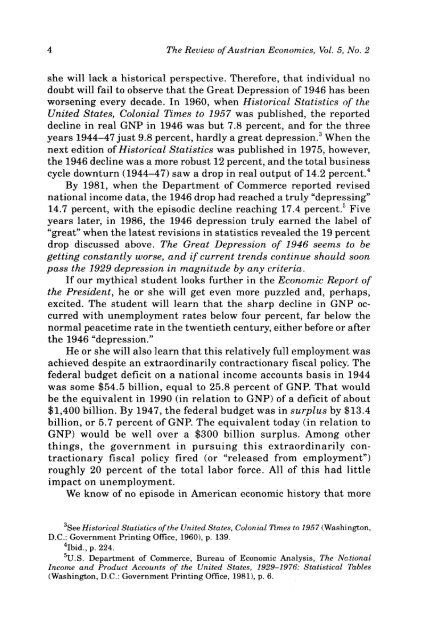Review of Austrian Economics - The Ludwig von Mises Institute
Review of Austrian Economics - The Ludwig von Mises Institute
Review of Austrian Economics - The Ludwig von Mises Institute
You also want an ePaper? Increase the reach of your titles
YUMPU automatically turns print PDFs into web optimized ePapers that Google loves.
4 <strong>The</strong> <strong>Review</strong> <strong>of</strong> <strong>Austrian</strong> <strong>Economics</strong>, Vol. 5, No. 2<br />
she will lack a historical perspective. <strong>The</strong>refore, that individual no<br />
doubt will fail to observe that the Great Depression <strong>of</strong> 1946 has been<br />
worsening every decade. In 1960, when Historical Statistics <strong>of</strong> the<br />
United States, Colonial Times to 1957 was published, the reported<br />
decline in real GNP in 1946 was but 7.8 percent, and for the three<br />
years 1944-47 just 9.8 percent, hardly a great depression. 3 When the<br />
next edition <strong>of</strong> Historical Statistics was published in 1975, however,<br />
the 1946 decline was a more robust 12 percent, and the total business<br />
cycle downturn (1944-47) saw a drop in real output <strong>of</strong> 14.2 percent. 4<br />
By 1981, when the Department <strong>of</strong> Commerce reported revised<br />
national income data, the 1946 drop had reached a truly "depressing"<br />
14.7 percent, with the episodic decline reaching 17.4 percent. 5 Five<br />
years later, in 1986, the 1946 depression truly earned the label <strong>of</strong><br />
"great" when the latest revisions in statistics revealed the 19 percent<br />
drop discussed above. <strong>The</strong> Great Depression <strong>of</strong> 1946 seems to be<br />
getting constantly worse, and if current trends continue should soon<br />
pass the 1929 depression in magnitude by any criteria.<br />
If our mythical student looks further in the Economic Report <strong>of</strong><br />
the President, he or she will get even more puzzled and, perhaps,<br />
excited. <strong>The</strong> student will learn that the sharp decline in GNP occurred<br />
with unemployment rates below four percent, far below the<br />
normal peacetime rate in the twentieth century, either before or after<br />
the 1946 "depression."<br />
He or she will also learn that this relatively full employment was<br />
achieved despite an extraordinarily contractionary fiscal policy. <strong>The</strong><br />
federal budget deficit on a national income accounts basis in 1944<br />
was some $54.5 billion, equal to 25.8 percent <strong>of</strong> GNP. That would<br />
be the equivalent in 1990 (in relation to GNP) <strong>of</strong> a deficit <strong>of</strong> about<br />
$1,400 billion. By 1947, the federal budget was in surplus by $13.4<br />
billion, or 5.7 percent <strong>of</strong> GNP. <strong>The</strong> equivalent today (in relation to<br />
GNP) would be well over a $300 billion surplus. Among other<br />
things, the government in pursuing this extraordinarily contractionary<br />
fiscal policy fired (or "released from employment")<br />
roughly 20 percent <strong>of</strong> the total labor force. All <strong>of</strong> this had little<br />
impact on unemployment.<br />
We know <strong>of</strong> no episode in American economic history that more<br />
3 See Historical Statistics <strong>of</strong> the United States, Colonial Times to 1957 (Washington,<br />
D.C.: Government Printing Office, 1960), p. 139.<br />
4 Ibid., p. 224.<br />
5 U.S. Department <strong>of</strong> Commerce, Bureau <strong>of</strong> Economic Analysis, <strong>The</strong> National<br />
Income and Product Accounts <strong>of</strong> the United States, 1929-1976: Statistical Tables<br />
(Washington, D.C.: Government Printing Office, 1981), p. 6.

















